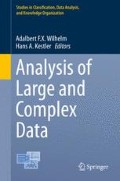Abstract
In this article author presents the results of comparative analysis in reference to scales based on 5-, 7-, 9-, and 11-point response categories. An attempt was made to find the optimum number of responses among these scales but in this regard to the assumptions underlying the Confirmatory Factor Model and MultiTrait-MultiMethod. For this purpose, the data was collected from a sample of young consumers (n = 200) studying at the universities in Poland. The specific aim of the research was focused on their attitudes, which measured different aspects of the companies’ unethical behavior in the context of marketing activities. For the comparison of scales, the author has applied four models derived from the generalized CFA-MTMM model. This model allowed the recommendation of the best scale, and also helped to evaluate the effects associated with the use of particular type of scale on the CFA-MTMM alternative models and extracted, through their agency, factors.
Access this chapter
Tax calculation will be finalised at checkout
Purchases are for personal use only
Notes
- 1.
In fact, the beginning of these models was due to works of Werts and Linn (1970) or Jöreskog (1970), who proposed to treat the MTMM matrix as a CFA model. Much later, because there were problems with estimation of the parameters in an ordinary CFA-MTMM model requiring at least three measures for each construct, Saris et al. (2004) have developed the Split-Ballot MTMM (or SB-MTMM) model where each respondent could answer all questions only twice.
- 2.
In practice, a hypothesized, e.g. CFA—Correlated Traits and Correlated Methods model is set as baseline and compared with the nested more restrictive models in which specific parameters are eliminated or are constrained to zero or 1.0.
- 3.
Adam Mickiewicz University, University of Technology, University of Economics, University of Life Sciences and University of Medical Sciences.
- 4.
They are computed on factor loadings either for factor traits or methods.
References
Alwin, D. F. (1992). Information transmission in the survey interview: Number of response categories and the reliability of attitude measurement In P. V. Marsden (Ed.), Sociological methodology (pp. 83–118). Washington: American Sociological Association.
Alwin, D. F. (2007). Margins of errors: A study of reliability in survey measurement. Wiley: Hoboken.
Browne, M. W. (1984). The decomposition of multitrait-multimethod matrices. British Journal of Mathematical and Statistical Psychology, 37, 1–21.
Byrne, M. B. (2010). Structural equation modeling with AMOS. New York: Taylor and Francis.
Campbell, D.T., & Fiske, D. W. (1959). Convergent and discriminant validation by the multitrait-multimethod matrix. Psychological Bulletin, 56, 81–105.
Dawes, J. (2008). Do data characteristics change according to the number of points used? an experiment using 5-point, 7-point and 10-point scales. International Journal of Market Research, 50, 61–77.
Jöreskog, K. G. (1970). A general method for the analysis of covariance structures. Biometrika, 57, 239–251.
Kenny, D. A., & Kashy, D. A. (1992). Analysis of the multitrait-multimethod matrix by confirmatory factor analysis. Psychological Bulletin, 112, 165–172.
Likert, R. (1932). A technique for the measurement of attitudes. Archives of Psychology, 140, 1–55.
Marsh, H. W. (1989). Confirmatory factor analyses of multitrait-multimethod data - many problems and a few solutions. Applied Psychological Measurement, 13, 335–361.
Marsh, H. W., & Grayson, D. (1995). Latent variable models of multitrait-multimethod data. In R. H. Hoyle (Ed.), Structural equation modeling: Concepts, issues and applications (pp. 177–198). Thousand Oaks, CA: Sage.
Revilla, A. M., Saris, W. E., & Krosnick, J. A. (2014). Choosing the number of categories in agree-disagree scales. Sociological Methods and Research, 43, 73–97.
Saris, W. E., & Andrews, F. M. (1991). Evaluation of measurement instruments using a structural modeling approach In P. P. Biemer, R. M. Groves, L. Lyberg, N. Mathiowetz, & S. Sudman (Eds.), Measurement errors in surveys (pp. 575–597). New York: Wiley.
Saris, W. E., Satorra, A., & Coenders, G. (2004). A new approach to evaluating the quality of measurement instruments: The splitballot MTMM design. Sociological Methodology, 34, 311–347.
Schmitt, N., & Stults, D. M. (1986). Methodology review: Analysis of multitrait-multimethod matrices. Applied Psychological Measurement, 10, 1–22.
Werts, C. E., & Linn, R. L. (1970). Path analysis: Psychological examples. Psychological Bulletin 74, 194–212.
Widaman, K. F. (1985). Hierarchically tested covariance structure models for multitrait-multimethod data. Applied Psychological Measurement, 9, 1–26.
Author information
Authors and Affiliations
Corresponding author
Editor information
Editors and Affiliations
Rights and permissions
Copyright information
© 2016 Springer International Publishing Switzerland
About this paper
Cite this paper
Tarka, P. (2016). CFA-MTMM Model in Comparative Analysis of 5-, 7-, 9-, and 11-point A/D Scales. In: Wilhelm, A., Kestler, H. (eds) Analysis of Large and Complex Data. Studies in Classification, Data Analysis, and Knowledge Organization. Springer, Cham. https://doi.org/10.1007/978-3-319-25226-1_47
Download citation
DOI: https://doi.org/10.1007/978-3-319-25226-1_47
Published:
Publisher Name: Springer, Cham
Print ISBN: 978-3-319-25224-7
Online ISBN: 978-3-319-25226-1
eBook Packages: Mathematics and StatisticsMathematics and Statistics (R0)

